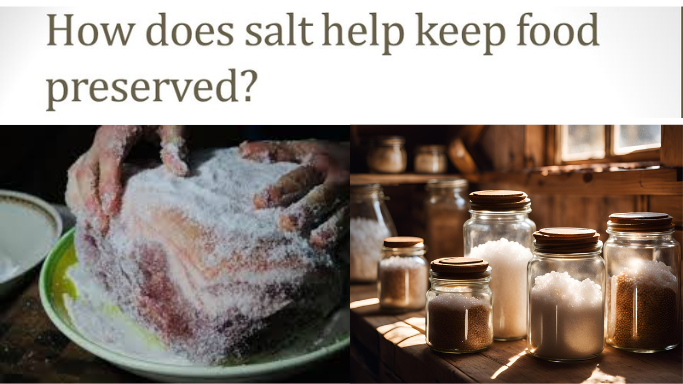Salt is one of the oldest and most widely used methods of preserving food. Before refrigeration and modern preservation techniques, people relied on salt to extend the shelf life of perishable foods. From meats to vegetables, salt has proven to be an essential tool in preventing spoilage and maintaining the nutritional value of food. But how exactly does it work to preserve food, and why has it stood the test of time? Let’s take a closer look at the science and history of salt in food preservation.
How Salt Works to Preserve Food
The preservation power of salt comes from its ability to draw out moisture. Salt is a hygroscopic substance, meaning it attracts water. When applied to food, salt draws water out of the food’s cells, creating an environment with lower moisture content. This is critical because bacteria, molds, and yeasts require moisture to grow and multiply. By reducing the water content, salt effectively inhibits the growth of these microorganisms, thus slowing down or preventing spoilage.
In addition to reducing moisture, salt can create an environment where microbial growth is discouraged. High concentrations of salt make the surrounding environment more salty than the inside of bacterial cells. This imbalance causes osmosis, where water from inside the bacteria is drawn out, essentially dehydrating and killing the microbes. This is why salted meats, like bacon and ham, can be preserved for long periods without spoiling.
Salt also helps in the process of fermentation, a method used to preserve foods like pickles, sauerkraut, and kimchi. When food is salted and then submerged in brine, the salt encourages the growth of beneficial bacteria, which outcompete harmful bacteria, and in turn, preserve the food while also creating unique flavors.
Types of Salt Used in Preservation
Different types of salt are used for different preservation techniques, but the most common are rock salt, sea salt, and kosher salt. Here’s a breakdown of their uses:
Rock Salt: Also known as halite, this is often used in salted meats and for preserving foods in brine. It has large crystals, making it effective for drawing out moisture from foods quickly.
Sea Salt: Harvested through the evaporation of seawater, sea salt can be used in both preservation and seasoning. It contains trace minerals that some believe add flavor and nutrients to preserved foods.
Kosher Salt: Its coarse grain and flaky texture make it ideal for curing meats. Kosher salt is particularly effective because it’s easy to handle and doesn’t contain additives like iodized salt.
Examples of Salt in Food Preservation
Cured Meats: Salted pork, bacon, and ham are classic examples of how salt is used to preserve meats. The salt draws out water, reduces microbial growth, and in many cases, gives the meat its characteristic flavor.
Pickling: One of the most well-known preservation methods, pickling involves immersing vegetables or fruits in saltwater brine. Salt promotes the fermentation process that preserves these foods while also adding a tangy flavor.
Cheese Making: Salt plays a vital role in the preservation of cheese. It helps in the aging process, draws out moisture, and prevents spoilage by inhibiting the growth of harmful bacteria while promoting the growth of beneficial bacteria needed for proper fermentation.
Fish Preservation: Before refrigeration, salting was the primary method used to preserve fish. Whether through dry salting or brining, salt keeps fish from spoiling by drawing moisture out of the flesh and creating a hostile environment for bacteria.
Salt and the Modern Food Industry
Although refrigeration and modern preservatives have largely replaced salt in many areas of food preservation, it is still widely used, particularly in the preservation of processed and cured foods. Many types of canned and frozen foods still use salt as a preservative to extend shelf life. Additionally, salt plays an essential role in food safety, especially in preventing botulism in canned goods.
Salt is also used in the production of ready-to-eat meals, snack foods, and frozen foods, where it not only acts as a preservative but also as a flavor enhancer. The rise of artisanal and natural food preservation techniques has also brought salt back into focus as a preservative of choice for many people who prefer less processed, more traditional methods.
Conclusion
Salt has been a key player in food preservation for centuries due to its ability to draw out moisture, inhibit bacterial growth, and promote fermentation. Whether used in curing meats, pickling vegetables, or preserving fish, salt is an effective and time-tested method of keeping food safe for long periods. While modern refrigeration and preservatives have made many old preservation techniques obsolete, salt still remains a crucial part of the food preservation process. Its versatility, simplicity, and effectiveness make it a tool that continues to serve as both a preservative and a flavor enhancer in the culinary world today.




